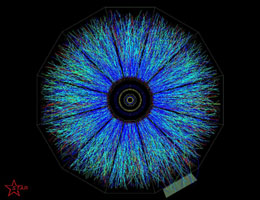RHIC and AGS Thesis Award 2008
Yesterday, my friend and colleague, Dr. Sarah Blyth from the University of Cape Town, was awarded the prestigious RHIC and AGS Thesis Award (to be posted soon) for her 2007 Ph.D. dissertation entitled: “Using the Phi Meson to Probe the Medium Created in Au+Au Collisions at RHIC.”
Since 1999, the Relativistic Heavy Ion Collider (RHIC) at Brookhaven National Laboratory, Long Island, has engaged in a program of cutting-edge nuclear science, studying nuclear and quark matter under extreme physical conditions. One of the primary systematic studies at RHIC collides gold (Au) nuclei together at 0.9999% the speed of light. The nuclei are then briefly literally boiled into their constituent quarks and gluons at temperatures reaching upwards of a trillion degrees centigrade. In the wake of the microscopic explosion, thousands of particles are unleashed, many of which are tracked by giant digital cameras the size of large houses. The STAR detector (shown below) is one such detector facility at RHIC, operated by an international collaboration of over 400 scientists. The resulting debris from a single central collision is shown head-on (looking down the beam) at the top of this post.

As one might imagine, dynamic nuclear systems like this are intrinsically very difficult to understand. This is not only because of the technical details in disentangling the thousands of particles in the final state of the collision, but because the exact details of the physics governing the processes are uncertain. The colliding system becomes a mixture of very different kinds of matter whose interactions are influenced by a host of different effective forces. Crudely speaking, it would be like trying to study the phases of water (gas, liquid, and solid) by observing the debris and water patterns left over after a water balloon fight. By analogy, scientists at RHIC have been trying to study the phases of nuclear matter under extreme conditions (rather than that of water) by colliding gold at very high velocity.
The quantum theory that describes the strong nuclear force holding nuclei together is called quantum chromodynamics (QCD). Ultrarelativistic (very high velocity) Gold-Gold collisions of the sort produced at RHIC are governed generally by two domains of of the theory: “Hard QCD” and “Soft QCD.” Hard QCD involves only the most direct and violent portions of the collision as well as their respective high energy byproducts. But, like with a water balloon collision, a surprisingly large amount of the initial energy dissipates into “soft” channels (e.g. thermal energy, low velocity dynamics, phase transitions, low mass particle production, etc.). Indeed, a large component of the collision can be very successfully modeled by relativistic hydrodynamics involving both partonic (i.e. quark and gluon) and (later in the explosion) hadronic flow. The discovery that the flow patterns produced in these collisions behaved as if the system was a perfect fluid (no viscosity), is one of the major breakthroughs of the RHIC program.
Dr. Blyth’s dissertation focused on one of several particular tests used to probe the relationship between hadronic and partonic flow as the system evolves and interplays between Soft QCD and Hard QCD. She then used this test, and data from the STAR detector, to examine in detail arguably the most complex and ill-understood portions of the collision.
As the RHIC program winds down, the Large Hadron Collider (LHC) prepares to begin operations this summer at CERN in Geneva, Switzerland. Some portion of the scientific program at the LHC is dedicated to studying at even higher energies the scientific questions regarding nuclear matter remaining after RHIC.
Congratulations, Sarah, for your reward! It must be exciting to be at the junction of two golden eras of relativistic heavy ion physics!

Very cool and very way over my puny head. Get any smaller than a proton, neutron, and electron and you’ve lost me.
Do you ever get out to the facility in Brookhaven for your work? I don’t live too terribly far away as the crow flies (near Edison, NJ, exit 10 off the NJ turnpike). Perhaps we could meet up…
drjohn said this on May 31st, 2008 at 3:45 pm
I read once that when Bill Clinton first became president his staff tried to ‘dumb him down’ so that people could relate to him. (not necessary for the current pres.) I think that television has made Americans ‘dumber.’ It is on so much and attention is giving to it even during commercials. I value time when I am alone and there is nothing to disturb my thoughts. I don’t think there is enough thinking in today’s society. I liked the article about the Phoenix on Mars and the picture.
sue said this on June 5th, 2008 at 6:57 pm